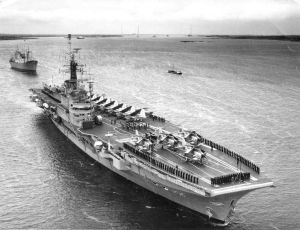HMS Centaur (R06)
 |
|
| History | |
|---|---|
|
|
|
| Name: | HMS Centaur |
| Builder: | Harland and Wolff |
| Laid down: | 30 May 1944 |
| Launched: | 22 April 1947 |
| Commissioned: | 1 September 1953 |
| Decommissioned: | 1965 |
| Homeport: | HMNB Portsmouth |
| Identification: | pennant number: R06 |
| Fate: | Scrapped in 1972-73 |
| General characteristics | |
| Class and type: | Centaur-class aircraft carrier |
| Displacement: | 24,000 tonnes full load |
| Length: | 737.75 ft (224.87 m) |
| Beam: | 123 ft (37 m) |
| Draught: | 27.8 ft (8.5 m) |
| Installed power: | 76,000 shp (57,000 kW) |
| Propulsion: | 4 Admiralty 3-drum boilers, 2 shafts, Parsons geared turbines |
| Speed: | 28 kn (52 km/h) |
| Range: | 7,000 nmi (13,000 km) at 18 kn (33 km/h) |
| Complement: | 1,390 (including air group) |
| Sensors and processing systems: |
Radars, Types 960/965(AW) 982(2 sets) 983 978 293. |
| Armament: |
|
| Armour: | 1–2 in (25–51 mm) on flight deck |
| Aircraft carried: | 42 (decreased to 26 with jet fighters). 1958-60 Sea Hawk & Sea Venom, 1961-63 Sea Vixen FAW1 & Supermarine Scimitar, 1963-65 12 Sea Vixen |
HMS Centaur was the first of the four Centaur-class light fleet carriers of the Royal Navy. She was the only ship of her class to be completed with the original design configuration of a straight axial flight deck, rather than the newly invented angled flight decks of her three later sister ships. She was laid down in 1944 in Belfast with the contract being awarded to Harland and Wolff but not launched until 22 April 1947 due to delays relating to the end of the war. She was commissioned on 1 September 1953, a gap of almost nine years from when she was laid down in 1944.
Centaur saw service throughout the 1950s and early 1960s. Due to budgetary issues Centaur was not converted to a commando carrier like two of her sister ships. Centaur was withdrawn from service in August 1965 and sold for scrapping in 1972.
Centaur was completed with an axial flight deck, marked by a broken white line running down the middle of the entire length of the flight deck. She began her contractor's sea trials in March 1953 and commissioned on 17 September 1953. Her aviation facilities as completed included 2 x BH5 30,000 lb (14,000 kg) hydraulic catapults at the bow, six 30,000 lb (14,000 kg) arrestor wires, two 35,000 lb (16,000 kg) capacity aircraft lifts, measuring 54 ft × 44 ft (16 m × 13 m) forward and aft. Her single hangar measured 329 by 62 by 17.5 ft (100.3 by 18.9 by 5.3 m) and she had stowage for 349,000 imp gal (1,590,000 L) of AVCAT and Avgas aviation fuel.
Following the completion of her sea and machinery trials in October 1953, she was taken in hand at Portsmouth Dockyard, to be fitted with an interim 5.5 degree angled deck, which was already being added to her as yet uncompleted sister ships, Albion and Bulwark. This required cutting down the port sheerstrake, re-siting the walkways and removing three twin Bofors guns and their directors. Upon completion of this work in April 1954, she was finally able to join the fleet as the first angled-deck carrier in the Royal Navy and undertook her initial flying trials in the English Channel from May to July 1954.
Centaur's first Captain, appointed on 13 August 1953, was Captain H.P.Sears, RN, who remained with her until replaced in October 1954, by Captain H.C.F Rolfe, RN, who was to stay with her until the end of her First Commission.
...
Wikipedia
